Transcriptional and post-transcriptional regulation of SPAST, the gene most frequently mutated in hereditary spastic paraplegia
- PMID: 22574173
- PMCID: PMC3344893
- DOI: 10.1371/journal.pone.0036505
Transcriptional and post-transcriptional regulation of SPAST, the gene most frequently mutated in hereditary spastic paraplegia
Abstract
Hereditary spastic paraplegias (HSPs) comprise a group of neurodegenerative disorders that are characterized by progressive spasticity of the lower extremities, due to axonal degeneration in the corticospinal motor tracts. HSPs are genetically heterogeneous and show autosomal dominant inheritance in ∼70-80% of cases, with additional cases being recessive or X-linked. The most common type of HSP is SPG4 with mutations in the SPAST gene, encoding spastin, which occurs in 40% of dominantly inherited cases and in ∼10% of sporadic cases. Both loss-of-function and dominant-negative mutation mechanisms have been described for SPG4, suggesting that precise or stoichiometric levels of spastin are necessary for biological function. Therefore, we hypothesized that regulatory mechanisms controlling expression of SPAST are important determinants of spastin biology, and if altered, could contribute to the development and progression of the disease. To examine the transcriptional and post-transcriptional regulation of SPAST, we used molecular phylogenetic methods to identify conserved sequences for putative transcription factor binding sites and miRNA targeting motifs in the SPAST promoter and 3'-UTR, respectively. By a variety of molecular methods, we demonstrate that SPAST transcription is positively regulated by NRF1 and SOX11. Furthermore, we show that miR-96 and miR-182 negatively regulate SPAST by effects on mRNA stability and protein level. These transcriptional and miRNA regulatory mechanisms provide new functional targets for mutation screening and therapeutic targeting in HSP.
Conflict of interest statement
Figures
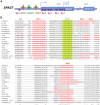


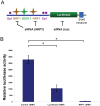
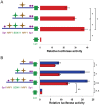

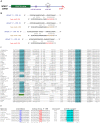
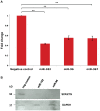
Similar articles
-
Amplifying the spectrum of SPAST gene mutations.Acta Biomed. 2021 Nov 18;92(S1):e2021220. doi: 10.23750/abm.v92iS1.11608. Acta Biomed. 2021. PMID: 35132972 Free PMC article.
-
A complex form of hereditary spastic paraplegia in three siblings due to somatic mosaicism for a novel SPAST mutation in the mother.J Neurol Sci. 2014 Dec 15;347(1-2):352-5. doi: 10.1016/j.jns.2014.09.046. Epub 2014 Oct 2. J Neurol Sci. 2014. PMID: 25315759
-
Hereditary spastic paraplegia SPG4: what is known and not known about the disease.Brain. 2015 Sep;138(Pt 9):2471-84. doi: 10.1093/brain/awv178. Epub 2015 Jun 20. Brain. 2015. PMID: 26094131 Free PMC article. Review.
-
Genetic analysis of SPG4 and SPG3A genes in a cohort of Chinese patients with hereditary spastic paraplegia.J Neurol Sci. 2014 Dec 15;347(1-2):368-71. doi: 10.1016/j.jns.2014.10.017. Epub 2014 Oct 16. J Neurol Sci. 2014. PMID: 25454648
-
A p.Arg499His mutation in SPAST is associated with infantile-onset complicated spastic paraplegia: a case report and review of the literature.BMC Neurol. 2021 Nov 9;21(1):439. doi: 10.1186/s12883-021-02478-0. BMC Neurol. 2021. PMID: 34753439 Free PMC article. Review.
Cited by
-
Gait Patterns in Patients with Hereditary Spastic Paraparesis.PLoS One. 2016 Oct 12;11(10):e0164623. doi: 10.1371/journal.pone.0164623. eCollection 2016. PLoS One. 2016. PMID: 27732632 Free PMC article.
-
The Role of Spastin in Axon Biology.Front Cell Dev Biol. 2022 Jul 5;10:934522. doi: 10.3389/fcell.2022.934522. eCollection 2022. Front Cell Dev Biol. 2022. PMID: 35865632 Free PMC article. Review.
-
Molecular and cellular mechanisms of spastin in neural development and disease (Review).Int J Mol Med. 2021 Dec;48(6):218. doi: 10.3892/ijmm.2021.5051. Epub 2021 Oct 19. Int J Mol Med. 2021. PMID: 34664680 Free PMC article. Review.
-
Mutations in the SPAST gene causing hereditary spastic paraplegia are related to global topological alterations in brain functional networks.Neurol Sci. 2019 May;40(5):979-984. doi: 10.1007/s10072-019-3725-y. Epub 2019 Feb 8. Neurol Sci. 2019. PMID: 30737580 Free PMC article.
-
Tau missorting and spastin-induced microtubule disruption in neurodegeneration: Alzheimer Disease and Hereditary Spastic Paraplegia.Mol Neurodegener. 2015 Dec 21;10:68. doi: 10.1186/s13024-015-0064-1. Mol Neurodegener. 2015. PMID: 26691836 Free PMC article. Review.
References
-
- Depienne C, Stevanin G, Brice A, Durr A. Hereditary spastic paraplegias: an update. Curr Opin Neurol. 2007;20:674–680. - PubMed
-
- Salinas S, Proukakis C, Crosby A, Warner TT. Hereditary spastic paraplegia: clinical features and pathogenetic mechanisms. Lancet Neurol. 2008;7:1127–1138. - PubMed
-
- Fink JK. In GeneReviews, ed. Pagon RA, Bird TC, Dolan CR, Stephens K, University of Washington, Seattle; 2009. Hereditary spastic paraplegia overview. - PubMed
Publication types
MeSH terms
Substances
Grants and funding
LinkOut - more resources
Full Text Sources
Other Literature Sources

